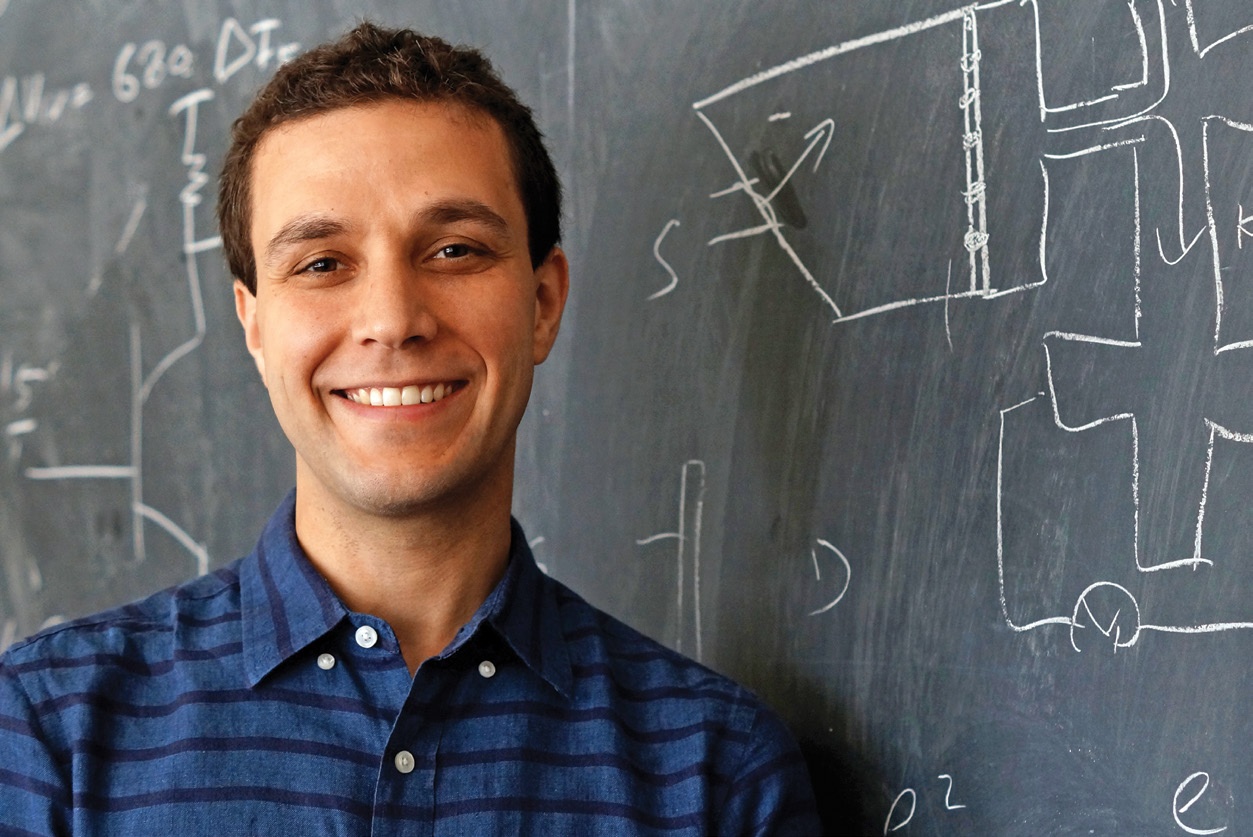Columbia College | Columbia University in the City of New York
Prizewinner Andrea Young ’06 is Expanding Physics’ Horizons

Sonia Fernandez / UC Santa Barbara
As a child in Washington, D.C., Andrea Young ’06, GSAS’12 liked to figure out how things worked. If you threw a ball, he could predict where it would land. “The idea that the world has a rational underlying machinery has always appealed to me,” he says.
Today, Young has moved well beyond playground experiments. An assistant professor at UC Santa Barbara, he recently won the 2018 New Horizons in Physics Prize, which goes to those who’ve made significant contributions to the field early in their career; Young was one of three honored this year. “It’s nice to be recognized,” he says. You don’t go into physics for the money or the fame.”
Young’s pioneering work is with graphene, a two-dimensional material derived from graphite. Although graphene is only a single-atom thick, it’s stronger than steel and has unique electronic properties. Young and his colleagues stack multiple sheets of graphene or other two-dimensional materials — akin to trying to layer sheets of plastic wrap one on top of the other, without any bumps — to create objects called van der Waals heterostructures. These structures allow scientists to observe new states of matter that don’t exist in three dimensions.
Physicists are excited about the potential of Young’s work to understand and observe phenomena that so far have only been described in mathematical equations and theories.
“The basic physics questions we’re interested in understanding are, ‘What kind of matter can exist? What makes one thing different from another?’” Young says. In their search for answers, Young and his colleagues build electrical devices from the tiny heterostructures they’ve made. They place the devices in severe conditions, like extremely cold temperatures and strong magnetic fields, and measure their electrical, magnetic and thermal signals and surface properties. Since the laws of physics function differently in two dimensions as compared to three, these experiments shed light on fundamental principles of quantum mechanics — the laws of physics that underlie the natural world and the way atoms behave — and potentially lead to new theories.
Young laid the foundation for his work with graphene at Columbia, where he earned a B.A. in physics and mathematics as well as an M.A. and a Ph.D. “It was a very special time in my career,” he says. “Columbia was the center of the universe for this type of physics, especially while I was a Ph.D. student. There was a lot of energy and ideas.”
Living in New York City was also a good way to balance his long days in the lab. “The idea that at 3 in the morning I could get something to eat, get a drink or find human life was psychologically very useful for me during that 10 years,” he says.
After getting his Ph.D., Young was a visiting scientist at the Weizmann Institute of Science in Israel and a Pappalardo Fellow at MIT. He’s received numerous honors, including the 2016 William L. McMillan Award, the 2016 Packard Fellowship for Science and Engineering and the 2017 Alfred P. Sloan Research Fellowship. In 2015, Young traded East Coast life for Santa Barbara, where he now lives with his wife and son.
Young is still interested in figuring out how things work. In the long term, that something is quantum computing, a holy grail of technology that promises to process extraordinary amounts of information and solve complex problems that regular computers can’t. Young’s part — through his experiments — is to find a way to protect quantum information and help create a stable quantum bit (“qubit”), the basic foundation for this type of computing.
To be honest, most days any possible applications to quantum computing seem a very long way away, he says. “But then there is a saying that people overestimate what can be done in three years and underestimate what can be done in 10.”
So what keeps him motivated? “Seeing something new pop up in your measurement is very exciting, and having a puzzle — say, some new piece of data you don’t understand — to think about is very engaging. The slog is worth it for the thrills when, every so often, something works.”
Christine Yu ’99 is a freelance writer in Brooklyn, N.Y.
Issue Contents
Published three times a year by Columbia College for alumni, students, faculty, parents and friends.
Columbia Alumni Center
622 W. 113th St., MC 4530, 6th Fl.
New York, NY 10025
212-851-7852
cct@columbia.edu
Columbia Alumni Center
622 W. 113th St., MC 4530, 4th Fl.
New York, NY 10025
212-851-7488
ccalumni@columbia.edu

